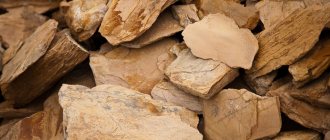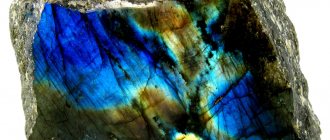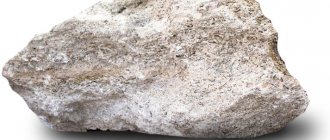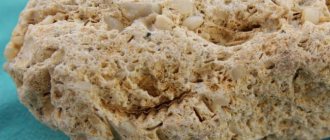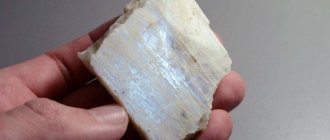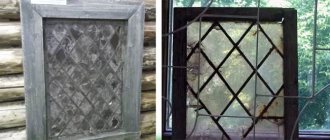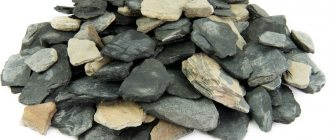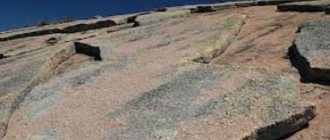Limestone is a rock formed by the deposition of carbonate material and subsequent modification by factors promoting cementation and recrystallization. The excellent technical parameters of the rock allow it to be used in many areas of production, construction, and metallurgy.
Limestone is a rock formed by the deposition of carbonate material and subsequent modification by factors promoting cementation and recrystallization
Conditions for the formation of carbonate deposits
Limestone is a mineral formation formed as a result of the deposition of skeletal remains of biological organisms and consisting primarily of calcite and partly aragonite. The chemical composition of limestone is close to calcite.
Carbonate material of various origins is common in sedimentary rocks. Similar to the quartz component, the sediments contain fragments of limestone, which is a product of the destruction of existing sediments.
Typical deposited limestone material is found in basal and carbonate conglomerates. Much more common are calcareous sandstones and breccias, consisting of fragments of material that have not been processed as a result of being transported over a distance by wind and water.
This fact allows us to assume their formation in shallow water conditions, in which a number of sections of the seabed rose above the water level and were destroyed as a result of abrasive processes.
It can be assumed that shell limestone was formed under such conditions. It is this type of sedimentary rock that is represented by the entire remains of organisms and their fragments.
We also recommend reading:
The history and curse of the Kohinoor stone The marvelous ametrine stone Characteristics of larimar and its main properties Selection of stones by date of birth
Many organogenic-clastic limestone rocks are represented by the products of sorting of not yet fossilized remains of shallow-water sediments. This type of accumulation forms a group of organogenic formations.
If bioherms (corals that form calcareous formations) immediately form hardened sediments, then the hardening of calcareous sediments is associated with additional chemical transformations of the carbonate part of the sediments.
Sometimes limestones are distinguished by a special spongy structure formed due to dolomitization. Such reef rocks contain oil.
Chemical industry
Even things like shoe polish, toothpaste, cleaning powder, etc., which we use every day, are derived from limestone. These raw materials are also used in the manufacture of products used to protect the environment from various types of pollution. Based on all of the above, we can safely say that the widely known and accessible material, which is limestone, represents the most important element of modern civilization.
The peoples of South and Central America made a great contribution to the development of stone carving. The Olmecs, Aztecs, and Mayans achieved significant success in the ability to make weapons, cutting tools and other household items from chalcedony, obsidian and silicon. Thus, they created rolling pins, grain grinders, mortars, etc. from basalt, sandstones and limestones. Percussion and chopping tools were made from diorite, jadeite, jade and other materials. The main centers for stone processing are the Mayan cities of Tonina and Nebah.
), consisting of small fragments and entire calcareous skeletons of microorganisms (coccoliths, foraminifera ( see.
FORAMINIFERS), etc.). Used in cement, glass, rubber and other industries.
Encyclopedic Dictionary . 2009.
See what “CHALK (limestone)” is in other dictionaries:
- LIMESTONE, sedimentary rocks formed at the bottom of a warm sea from the remains of living creatures that lived in the water. At least 50% of limestone consists of calcite (CaCO3). There are many different types: Carboniferous limestone, CHALKET, oolitic and... ... Scientific and Technical Encyclopedic Dictionary
Abbr. name Cretaceous system and period. Geological Dictionary: in 2 volumes. M.: Nedra. Edited by K. N. Paffengoltz et al. 1978. Chalk ... Geological Encyclopedia
A (y), prev. about chalk, in chalk; m. 1. Soft white limestone. Chalk mining. // A piece of this limestone; powder or solution used for writing, whitewashing, cleaning, etc. Dissolve the m. Whitewash the ceiling with chalk. Write on the board with chalk. The entire sleeve is in ... Encyclopedic Dictionary
Calcilutite, zoolite, madreporite, shell rock, chalk, phytolite Dictionary of Russian synonyms. limestone noun, number of synonyms: 16 anthraconine (2) ... Dictionary of synonyms
Sanguine, chalk, limestone Dictionary of Russian synonyms. chalk noun, number of synonyms: 6 limestone (16) ... Dictionary of synonyms
Dahl's Explanatory Dictionary
CHALK, (stranded?) male, bonfire, Perm. yeast, yeast. II. MEL husband soft, powdery limestone; aqueous lime carbonate, white paint. | north and east yeast, yeast (or chalk?), in yarosl. stranded noun | Chalk, in birds of prey, disease, hard white... ... Dahl's Explanatory Dictionary
Limestone
- - sedimentary rock, chemical composition - calcium carbonate CaCo3; used as a facing material (for example, in plinths), for the manufacture of cornice slabs, blocks for stands, intermediate blocks in column trunks, ... ... Encyclopedia of terms, definitions and explanations of building materials
See Limestones. Geological Dictionary: in 2 volumes. M.: Nedra. Edited by K. N. Paffengoltz et al. 1978. Limestone ... Geological Encyclopedia
CHALK, a (y), about chalk, in chalk, husband. Soft white limestone, used. in industry, for painting, writing. Write with chalk on a blackboard. White as m. | adj. chalky, oh, oh. Chalk mountains. Ozhegov's explanatory dictionary. S.I. Ozhegov, N.Yu. Shvedova. 1949 1992 ... Ozhegov's Explanatory Dictionary
Data-lazy-type=”image” data-src=”https://karatto.ru/wp-content/uploads/2017/12/izvestnyak-1.jpg” alt=”white limestone” width=”350″ height =»204″> Everyone is familiar with limestone: both pliable chalk and durable marble are essentially it. The mineral is unprepossessing in appearance, not rare in nature, and not difficult to process. And with all this, he managed to become famous in culture and history: ancient Egyptian pyramids, majestic temples and cathedrals, the famous Wall of China, the Moscow Kremlin and other masterpiece buildings were created from it. There are many signs associated with it; truly miraculous properties are attributed to it. The origin of natural limestone, its varieties, and various uses will be discussed further.
Types of formations
Chemogenic formations (rocks formed without the participation of biological processes) are divided into types depending on the structure of the rock and the grain size of the carbonate clastic material and determine the nature of the rock formation and the origin of the limestone.
Micrograined rock is the result of the vital activity of microorganisms and is a product of their processing of calcium nitrate into a carbonate compound.
White limestone, which is a mass of micro-grained carbonate material, is not usually composed entirely of chemogenic sediment. As a detailed study of writing chalk under a microscope shows, the microgranular part of the calcium carbonate compound (limestone formula CaCO3) contains the remains of the skeletons of microscopic coccolithophorid organisms.
The second type of formations is represented by calcareous crusts and characteristic inlays. The sediments formed directly on the bottom of the sedimentary basin, evenly distributed over the fossilized sediment.
White limestone, which is a mass of micro-grained carbonate material, is not usually composed entirely of chemogenic sediment
Favorable formation conditions at the bottom of shallow areas could be suitable for the direct release of calcium carbonate and characterized by an increased temperature gradient.
Among the hemogenic formations other than coral reefs are concentric oolites, which form a special type of sediment. The cores of the formations contain carbonate or other sandstones and foraminifera.
The recrystallization of sediment that occurs in reef limestones is associated with coarsening mineral encrustations under conditions of additional sedimentation in the upper parts of the silt.
The process can be facilitated by shallowing conditions if they lead to an increase in water temperature and an upward change in the level of the neutral environment. The degree of crystallization distinguishes or brings together successively changing layers of limestone sediments.
Complete recrystallization of sediments with the destruction of the cemented material completely erases the difference between fragmentary material and cement. An example of this type of deposit is marbled limestone.
The uneven development of crystallization processes in the rock determines the coarse-grained structure of sediments.
Comparison
The areas of application of chalk and lime (it would be more correct to say lime, since there are several of them) differ quite greatly. We all know student chalk, which is widely used in school, but this is only one of its “specialties”. In addition, it has found application in the production of high-quality coated paper, as well as in the creation of certain types of rubber and in the food industry. Chalk often plays the role of a filler in various compositions - from paint and varnish products to polymers (polypropylene and polyethylene). And, finally, what makes it similar to slaked lime is that both of these materials are suitable for whitewashing tree trunks, borders, fences, and so on.
Technical Parameters of Limestone
Dolomites and limestones containing magnesium carbonate have greater hardness. They are more difficult to mechanically influence.
Natural limestone is durable and hard. When crushed, it forms an uneven fracture. Doesn't get wet in water. The physical properties of the rock allow it to be used in construction.
Usually the carbonate compound is white, gray in color. But depending on the presence of impurities, the external color and technical characteristics of limestone change. The minerals contained in the formation not only change color, but also affect strength, stability and determine the scope of application.
The carbonaceous substance colors the rock black, the yellow color is determined by the presence of iron hydroxides, and the greenish color is determined by glauconite.
A description of the technical parameters of the material is contained in the deposit passport. The information collected in the document fully reflects the properties of the breed and its compliance with state standards regulated by law.
The structure of limestone allows us to distinguish types of rock. The texture of the mineral formation is uniform, sometimes there are pores and cavities (voids).
Limestone stone deposits
Some mountain ranges are entirely composed of this mineral. The breed is widespread in the Alps and Crimea.
Of the continents, North America is also rich in stone, but Australia is lagging behind in this sense: its constituent rocks do not contain calcite.
The most fertile deposits are concentrated in the Caucasus, the Siberian region, and the Urals. China is an important supplier of a type of construction mineral – marl.
The Zhdanovskoye deposit, which was developed on the territory of the Russian Federation in the Orenburg region, is recognized as a very promising modern source of limestone.
What are formations characterized by?
Among carbonate deposits, the following types of limestone are distinguished:
- dense carbonates (characterized by a homogeneous structure);
- oolitic formations of spherical shape;
- tuffs are formations with large pores, which are durable and easy to process (polished, grinded);
- travertine – sinter formations;
- clayey and bituminous limestones.
The coral limestone in the sediments is supplemented with an admixture of foraminiferal shells and mollusks, and echinoderm shells. The rock that makes up modern reefs has a hard, porous structure and consists of the skeletons of colonies of polyps.
Putilov limestone is known as the main building material used during the construction of the city of St. Petersburg. The name of the rock is associated with the Putilov deposit located nearby.
The density of limestone is average, it does not collapse under the influence of shock loads, and is resistant to abrasion, aggressive acidic environments and salts. It contains small voids formed as a result of rock leaching.
The color of limestone is gray, alternating with dark gray. The crystalline mineral formation of organogenic origin contains dolomite (2-25%), glauconite grains (up to 20%), phosphates (2-3%), grains of silicate compounds (quartz).
Due to its external similarity, limestone is often mistaken for marble. The difference between breeds lies in the form of their formation. For example, the black Portoro marble from which sculptures are created is a sedimentary rock. The structure of limestone is different from marble.
The formation of marble occurs through the process of metamorphic changes and recrystallization of rock. It contains no traces of fossils.
If the conversion process is not completed, the result is marbled limestone. It is this rock that contains white calcite inclusions of bioherms (corals), shells, and fragments of skeletons of other marine inhabitants.
The petrographic and mineralogical definition of the rock is “marble-like limestone.” In the literature on engineering geology, in the section devoted to the classification of rock types, incompletely transformed limestone is called marble.
Dolomitized limestone is a gray and dark gray sedimentary rock composed of calcite and dolomite. The mineral composition of the formations is formed by inclusions of gypsum, anhydrite and silicon, feldspars, pyrite, clayey matter and flora relics (blue algae).
The strength of limestone, which includes magnesium carbonate (about 40%), during compression is 400-1300 kgf/cm², the hardness of dolomite on the Mohs scale is 3.5-4.5.
Properties and uses of limestone
The mineral is used everywhere taking into account its properties. The strength of limestone is influenced by the external environment. Building materials will last a long time in a dry climate without sudden temperature changes. During prolonged rains, the surface of the product collects moisture and may erode. In the event of sudden frosts, wet slabs begin to crack.
In the Russian climate, only one type of limestone is suitable for street work and facade finishing - Jurassic marbled limestone, mined in Germany. This stone is certified in Russia and meets the requirements of GOST 9480-2012, GOST 23342-2012 and GOST 9479-2011. According to the test report, Jurassic stone can easily withstand 150 winter/summer cycles, which is the main requirement for obtaining a certificate and permission to cladding the facades of city buildings.
Therefore, for industrial use, limestone stone is subject to standardization. The marking indicates the capital letters of the name and size of the stone, and the percentage of trace element oxides.
Mineral standards:
| Industry | GOST | Type of limestone fraction | Brand |
| Glass | 23672-79 23673.1-79 23673.2-79 23673.3-79 23673.4-79 23673.5-79 | Lump | IK-54-0.1 IK-53-0.2 IK-51-0.3 |
| Road | 8267-93 | Crushed stone | M 800 M 900 M 1000 M 1100 M 1200 |
| Construction | 8267-93 4001-84 9479-84 9480-89 9179-77 3342-91 | Crushed stone | M 300 - M 1200 |
| Wall stones | |||
| Blocks | |||
| Cladding slabs | |||
| Lime | |||
| Architectural products |
Since limestone is heavier and not lighter than water, whitewash, coloring emulsions and other solutions are prepared on its basis. Screenings (powder) are added to cement, putty, and plastic. Included in mixtures for the production of shoe polishes, toothpastes, bitumen, paper, rubber, reinforced concrete, paving slabs. In winter, the road is covered with ice.
The screenings are filled with feed or fertilizer (mineral additive), and the acidified soil is alkalized. It is included in drinking water filters.
In the aquarium, washed porous stones are placed on the bottom for decoration and to enrich the water with calcium.
In addition, watch the video:
View this post on Instagram
Publication from MASTER FASADA • Pyatigorsk (@master_fasada) May 23, 2019 at 12:14 PDT
View this post on Instagram
Publication from Stone Industry (@ind_kam) Jun 15, 2021 at 6:12 PDT
Physicochemical characteristics
The mineral is formed by combining carbonic acid with calcium. Limestone without impurities has a chemical formula written as CaCO3. Limestone is decomposed by acids H2SO4, CH3COOH, HCl. Calcium remains in solution, carbon dioxide CO2 evaporates.
Physical characteristics of limestone:
- decomposition – insoluble in water;
- abrasion - with friction without effort, the area decreases;
- density – 2.5 g/cm3;
- on the Mohs scale, hardness out of 10 points is 3;
- porosity – 35%;
- water absorption – 0.1–2%;
- dry strength – average;
- water absorption strength – minimal;
- frost resistance – up to – 40 ºC;
- burning - no.
Additional minerals add strength to limestone, reduce porosity to 2–30% and water absorption to 0.1–1%. The crystallized texture can withstand compression of 300 megapascals, shell rock - 0.4 MPa.
Mineral composition by type of limestone:
- dolomitized – Ca + MgO2 (magnesium oxide);
- organogenic, detrital or chemogenic – Ca + SiO2 (silicon oxide);
- ferrous – Ca + FeO2 (iron oxide, colors the structure yellow);
- manganese – Ca + MnO2 (manganese oxide, gives pink color);
- clayey – Ca + Al4[Si4O10](OH)8 (kaolin).
The structure of limestone stones is porous, layered or granular. In the latter case, the texture shows thin, small, large or unequally sized rounded particles.
Medicinal properties
In premises, the air is disinfected with limestone, and a solution is applied to the walls to remove fungus. Water purified with calcite filters is beneficial. It removes allergens, toxic products of viruses and bacteria from the body.
Lithotherapists recommend holding a natural stone in your hands or applying or massaging it to the painful area. The color of the mineral matters.
When and what kind of limestone helps:
- hypertension – blue;
- sleep disorders, depression, neurological diseases – pink, red;
- impaired digestion – yellow;
- diseases of the blood, hematopoietic organs, heart, blood vessels - red.
The mineral has antimicrobial and sorbing properties. Helps with skin diseases, acne. A mixture of powder and water is added to baths, applied to the face, and made into lotions and wraps.
Magic properties
Esotericists advise lawyers, doctors, engineers, and accountants to use limestone. You should carry the stone with you or put a figurine made of it in your office. The amulet will protect you from wrong decisions. It helps creative people to cheer up, find inspiration, and get rid of laziness and apathy.
The yellowish mineral is used during meditation. For a woman, light calcite will attract the attention of the man she likes and will strengthen the affection of those around her. Regardless of gender, a person’s intuition increases, the ability to calculate the result of actions and predict the situation improves.
According to the horoscope, astrologers do not recommend using limestone only for people with the sign of Scorpio. Their energy does not coincide with the stone, so an imbalance begins in love and business.
Limestone is common on most continents. Availability and ease of processing have allowed people to use stone since ancient times. The hardened mineral is used to write, decorate landscapes, build houses, and add to ore when smelting metal. It does not serve only as fuel, although there are even petroleum products in bitumen form.
What do you know about limestone? Comment on the article, write interesting facts, share information with friends on social networks. All the best.
Application of rock
Limestone in construction is used as a raw material in the formation of road surfaces, lime production and cement production.
It is used as a material for finishing work. Ease of processing, softness, and a variety of colors make it possible to use it for finishing rooms, creating architectural structures, and decorative items.
Crushed stone and limestone chips are used as concrete filler. But it is better to use sandstone as a material for forming the foundation and foundation of buildings and structures, because limestone is not resistant to water.
Limestone is used as a fertilizer; it must first be ground into flour. Like other fertilizers that contain magnesium, dolomite has a positive effect on soil of light texture. Its use increases the yield of industrial crops (corn, sugar beets), legumes, and potatoes.
Limestone containing dolomite is not used to make Portland cement. When rock, which contains no more than 8% clay impurities, is roasted until carbon dioxide is completely released, a building material (lime) is obtained.
Limestone in construction is used as a raw material in the formation of road surfaces, lime production and cement production.
The properties of limestone to acquire a smooth surface during processing are used in lithography for printing multi-colored stamps, drawings, and maps. To do this, the original image is applied to a polished plate of homogeneous and dense limestone using a special pencil or thick ink.
Sugar production involves the use of lime as a sorbent material. Limestone is used to make abrasives, tooth powder, paints, and mineral wool.
The rock is used as a filler in glass production. The mineral additive improves product quality, gives strength and resistance to temperature fluctuations.
Fluxed limestone and dolomite are used in ferrous metallurgy. Its use is determined by the chemical composition of the base rock, which contains oxides of calcium, iron, and magnesium.
The fluxing additive is designed to extract melt from rock that does not contain a valuable component or harmful impurities. It is these mineral formations that are used in production and meet the basic requirement of a low content of sulfur, phosphorus, alumina, silicate compounds and silica.
The use of a carbonate compound helps to lower the temperature gradient of ore melting and liquefy slag. The use of limestone in the form of a filler for certain grades of paper makes it possible to reduce the cost of production while maintaining basic quality parameters.
Limestone in modern industrial production
It turns out that this natural material is used in the production of paints, rubbers and plastics. And purified from impurities harmful to the human body, it is used even in the food industry. Glass production is not possible without limestone, since it is the main source of calcium. This breed has become an indispensable and, most importantly, an affordable component for paper production. In everyday life, we constantly use products such as pipes, linoleum, tiles, tiles, etc., and do not realize that limestone is also present in all these items. Even plastic production (PP, PVC, crepe, lavsan, etc.) cannot do without this raw material. Paints use calcium carbonate as a coloring pigment. As you can see, this material occupies a leading place in almost all industries.
Carbonate rock deposits
Work on the preparation and development of deposits is carried out in the following sequence:
- clearing the territory of the top fertile layer with its subsequent storage for the purpose of land reclamation;
- moving the clay layer using electric excavators;
- sampling of substandard raw materials;
- clearing access to limestone;
- carrying out blasting operations;
- loading of raw materials;
- cleaning the area and transporting waste to dumps.
The solid layer of limestone that was not exposed to the explosion is drilled and explosive materials are laid for re-work. For drilling, electric installations are used that make it possible to make a hole in the rock to a depth of 24 m and a diameter of 16 mm.
The distance between the wells stretched in a line is 5 m. TNT is used as detonators. For one explosion, about 30 holes are drilled.
The carbonate compound is not uncommon, and deposits can be found throughout the world. Limestone is extracted using open-pit (quarry) methods.
Work related to the exploitation of the deposit requires compliance with safety precautions with explosives. It is necessary to adhere to regulated standards for performing loading and unloading operations and forming dumps.
Limestone deposits in Russia are located in almost every corner of the country (Voronezh, Arkhangelsk, Belgorod, Vologda regions, Siberia).
Carbonate deposits in the Russian Federation are located in various cities, and the Krasnodar Territory is no exception. In coastal areas, raw materials are extracted that are characterized by high strength and a variety of textures.
The development of deposits is closely related to the needs of production and construction. It is not economically profitable to transport the extracted material over long distances, so quarries are usually located near industrial facilities involved in the processing of ore raw materials, construction, and cement production.
Deposits where limestone is mined are often bordered by layers of clay or sand. But the presence of small cracks in the bedrock helps speed up the process of extracting material.
How is limestone mined?
How is limestone mined
Limestone is mined in quarries. This option for extracting minerals is called open. At the first stage, so-called stripping operations are carried out. They involve removing the top layers of soil under which the mineral is located. During the operation of the quarry, mining is carried out directly. After its completion, reclamation measures are carried out.
The mining procedure involves grinding (crushing) the rock on site, followed by transporting it to the processing site. Explosions and other methods and technologies are used to grind it. The latter include excavators - giant machines that dig into a layer of limestone rock. Hydraulic loosening methods are also used.
Benefits of using limestone
Compared to other materials, limestone has the following advantages:
- The undoubted advantage of limestone is its high environmental friendliness;
- It lends itself perfectly to processing, which allows you to give it almost any shape and texture;
- Unlike, for example, brick or facing tiles, limestone retains its appearance for a very long time. Even if its surface is constantly exposed to adverse weather factors. That is why limestone is often used when cladding building plinths;
- Limestone has a porous structure, which allows it to perfectly absorb moisture from the environment. Therefore, the humidity in the room will be at the optimal level;
- High heat and sound insulation characteristics make the material ideal for exterior and interior decoration.
As you can see, limestone is an excellent material that can be used in many industries, mainly in the construction industry. Its excellent qualities allow us to say with confidence that this is the best material in its category.
History and origin of the breed
Limestone was used in ancient times. The Greeks built temples of the gods from it. In Egypt, the pyramid of Cheops was laid out with hewn monoliths. In Russia and Malta, buildings and cathedrals were erected from it. Archaeologists have found many stone figurines, stucco moldings, and interior items.
Limestone requires sedimentary rock to form. It appears in two ways. In the first case, this is the precipitation of substances from hot solutions, for example near thermal springs. Petrification occurs during the cooling process.
In the second option, the remains of fish skeletons, mollusk shells, and other organic elements settle to the bottom. The thickness of the water contributes to their compaction and subsequent hardening.
This sedimentary rock is also called rock. The explanation is simple: subsidence occurs over a long period of time over a large area. The result is massive strata containing various fossilized minerals. Sediments change the bottom topography, forming hills. After the ancient seas dried up, mountains with sedimentary rocks were left on the earth, where limestone was first found.
Well-known “relatives” of the mineral are marble and soda ash.
The first is formed during the process of metamorphosis, which caused the recrystallization of limestone. The second deposit contains sodium
Description
The basis of limestone is calcium carbonate, a substance that can dissolve in water. As a result, karst is formed. It can decompose into bases and carbon dioxide. This is carried out at great depths, because due to the influence of the Earth’s heat, limestone forms gas for mineral waters.
Limestone may include admixtures of clay minerals, dolomite, quartz, gypsum, and pyrite. Natural limestone is light gray in color, although it can be black or white. Impurities give a blue, pink, yellow tint. Limestone mining is in demand due to its widespread use. The breed is durable and known for its unique characteristics that make it unlike other materials.
Application of development methods
Rock characteristics and development conditions play a significant role in choosing a method. Thus, tractor rippers are relevant for rocky and semi-rocky rocks. Fractured rocks are destroyed along cracks. The loosening depth is 0.3-0.7 m. Due to the ineffectiveness of the excavator, bulldozers are used in such conditions. The use of rippers reduces the cost of work by 15-20%, but their effectiveness depends on the properties of the rocks. They are most appropriate in thin formations, where they can reduce the cost of production by 2-5 times compared to explosive technology. The drilling and blasting method is preferable when mechanical analogues are ineffective. These are dense and hard rocks.
Order service
Fill out an application and we will contact you shortly
